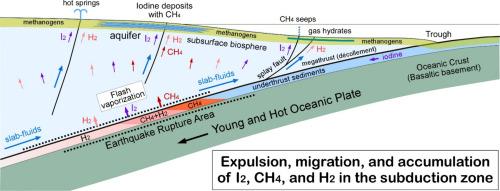大洋板块俯冲带碘的闪蒸与迁移
IF 3.6
2区 地球科学
Q1 GEOCHEMISTRY & GEOPHYSICS
引用次数: 0
摘要
俯冲带的地壳流体,如地下含水层、海底渗漏和天然气水合物水,通常富含碘(I2)和甲烷(CH4)。在太平洋板块(PAC)和菲律宾海板块(PHS)俯冲的关东俯冲带,大规模含水层也表现出高浓度的I2和CH4。然而,I2在俯冲带的成因和行为尚不清楚,其与CH4的共存也未得到解决。为此,编制了高压高温(P-T)条件下的I2相图,预测了其在俯冲带的物理化学性质。然后,我们将俯冲的PAC和PHS沉积物的P-T路径应用于I2相图。我们的研究结果表明,I2可以在年轻和热的PHS俯冲带中以液体形式存在。地震破裂时的短暂减压会导致液态碘迅速蒸发并从俯冲沉积物中排出。与I2一起,俯冲沉积物中产生的热源CH4和氢(H2)也被释放并向上运移,可能是通过板状脱水流体。此外,H2可以通过氢营养产甲烷作用促进微生物CH4的产生。在小灵通等年轻和热洋板块的俯冲带,由于I2、CH4和H2同时从同一俯冲沉积物中排出并通过深部流体运移,地壳流体富集I2并与CH4共存。大型地下含水层可作为I2和CH4运移的圈闭和储集层,形成大规模的I2和CH4矿床。本文章由计算机程序翻译,如有差异,请以英文原文为准。

Flash vaporization and migration of iodine in the oceanic plate subduction zone
Crustal fluids in subduction zones, such as subsurface aquifers, submarine seeps, and gas hydrate waters, are often rich in iodine (I2) and methane (CH4). Large-scale aquifers in the Kanto subduction zone, where the Pacific Plate (PAC) and the Philippine Sea Plate (PHS) are subducting, also exhibit high concentrations of I2 and CH4. However, the origin and behavior of I2 in the subduction zone are unclear, and its coexistence with CH4 remains unresolved. To investigate this, we compiled the I2 phase diagram under high-pressure and high-temperature (P–T) conditions to predict its physicochemical properties in the subduction zone. We then applied the P–T paths of subducted PAC and PHS sediments to the I2 phase diagram. Our findings reveal that I2 can exist as a liquid in the young and hot PHS subduction zone. Transient decompressions during earthquake ruptures can cause liquid iodine to flash-vaporize and be expelled from subducted sediments. Along with I2, thermogenic CH4 and hydrogen (H2) generated in the subducted sediments are also released and transported upward, likely by slab-dehydrated fluids. Additionally, H2 may enhance microbial CH4 production through hydrogenotrophic methanogenesis. In subduction zones of young and hot oceanic plates such as the PHS, crustal fluids are enriched in I2 and coexist with CH4 owing to the simultaneous expulsion of I2, CH4, and H2 from the same subducted sediments and their migration via deep fluids. Large subsurface aquifers can act as traps and reservoirs for migrating I2 and CH4, forming large-scale I2 and CH4 deposits.
求助全文
通过发布文献求助,成功后即可免费获取论文全文。
去求助
来源期刊

Chemical Geology
地学-地球化学与地球物理
CiteScore
7.20
自引率
10.30%
发文量
374
审稿时长
3.6 months
期刊介绍:
Chemical Geology is an international journal that publishes original research papers on isotopic and elemental geochemistry, geochronology and cosmochemistry.
The Journal focuses on chemical processes in igneous, metamorphic, and sedimentary petrology, low- and high-temperature aqueous solutions, biogeochemistry, the environment and cosmochemistry.
Papers that are field, experimentally, or computationally based are appropriate if they are of broad international interest. The Journal generally does not publish papers that are primarily of regional or local interest, or which are primarily focused on remediation and applied geochemistry.
The Journal also welcomes innovative papers dealing with significant analytical advances that are of wide interest in the community and extend significantly beyond the scope of what would be included in the methods section of a standard research paper.
 求助内容:
求助内容: 应助结果提醒方式:
应助结果提醒方式:


